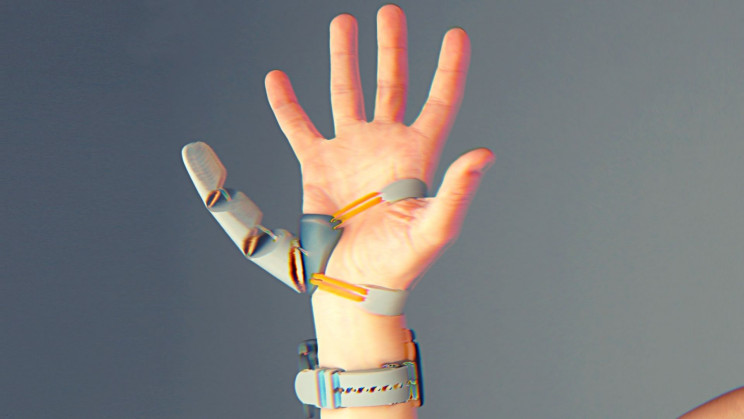You’d never guess it, but a robotic “third thumb” can change the way your hand is represented in your brain, according to a new study published in the journal Science Robotics. The research may be paving the way for cybernetic augmentation.
The research team trained humans to employ a robotic extra thumb and discovered that they could effectively execute complex and dexterous tasks, including building a tower of blocks using their double-thumbed hand. As participants continued to train, they remarked on how it increasingly felt like just another part of their body.
Called the Third Thumb, the device’s development was part of an award-winning graduate project at the Royal College of Art, under the leadership of Lead Designer Dani Clode. The project aimed to change the way we think about prosthetics, from the basics of restoring a lost function to a more modest extension of human capabilities. Clode was subsequently invited to join a team of neuroscientists at the University College London, led by Professor Tamar Makin, who were exploring the ways brains adapt to augmented bodies.
“Body augmentation is a growing field aimed at extending our physical abilities, yet we lack a clear understanding of how our brains can adapt to it,” said Makin of the UCL’s Institute of Cognitive Neuroscience and lead author of the study, in an embargoed release shared with IE. “By studying people using Dani’s cleverly-designed Third Thumb, we sought to answer key questions around whether the human brain can support an extra body part, and how the technology might impact our brain.”
Notably, the Third Thumb is completely 3D-printed, which means customization comes easy. It’s worn on the side of the hand, opposite your flesh-and-blood thumb, in proxy to pinky. The wearer of the Third Thumb can control it via pressure sensors equipped on their feet, below the big toes. Wirelessly connected, the two toe sensors manipulate the motion of the robotic Thumb by instantly reacting to subtle changes in the pressure of toe on sensor. The study involved 20 participants who were each trained for five days to use the robotic thumb, often taking the thumb home every day to test it out on daily domestic tasks. In all, the wearers each wore their robotic thumbs for two to six hours every day. This group of robot thumb-wearers was contrasted with another group of 10 control participants who donned a static, unmoving robotic thumb while executing identical training tasks.
The daily lab sessions saw the participants focus their robot thumb training on tasks designed to enhance the cooperation between their hand and the Third Thumb, like single-handedly grabbing multiple balls or wine glasses. During training, the participants learned the basic gestures needed to use the thumb quickly, with improved motor control, hand-Thumb coordination, and dexterity directly correlated with training. Eventually, the participants used the Thumb when distracted, whether building a wooden block tower while thinking through a math problem or blindfolded.
“Body augmentation could one day be valuable to society in numerous ways, such as enabling a surgeon to get by without an assistant, or a factory worker to work more efficiently,” said Paulina Kieliba of the UCL’s Institute of Cognitive Neuroscience, in the embargoed release. “This line of work could revolutionize the concept of prosthetics, and it could help someone who permanently or temporarily can only use on hand, to do everything with that hand.”
“But to get there, we need to continue researching the complicated, interdisciplinary questions of how these devices interact with our brains,” added Kieliba. The team scanned participants’ brains via an fMRI before and after the training while users moved their individual fingers, with no robotic Third Thumb attached. Crucially, the fMRI detected subtle but substantial changes to how the hand augmented with a robotic thumb was represented in the brain’s sensorimotor cortex. Our brains represent each finger in a way distinct from all others, and, after the robotic finger training, the new activity pattern corresponding to each individual finger becomes more similar. These changes in brain activity dissipated a week later in participants, hinting at robotic prosthetics as a short-term solution.
“Our study is the first one investigating the use of an augmentation device outside of a lab,” said Kieliba in the embargoed release. “It is the first augmentation study carried over multiple days of prolonged training, and the first to have an untrained comparison group. The success of our study shows the value of neuroscientists working closely together with designers and engineers, to ensure that augmentation devices make the most of our brains’ ability to learn and adapt, while also ensuring that augmentation devices can be used safely.” The future of human motion will undoubtedly see extensive augmentation with robotic limbs and extensions. While our brains didn’t evolve to use more than a typical baby is born with, they are more than capable of adapting, and rising to the task of a cybernetic future.
Source: Science Robotics, Interesting Engineering

